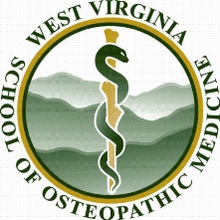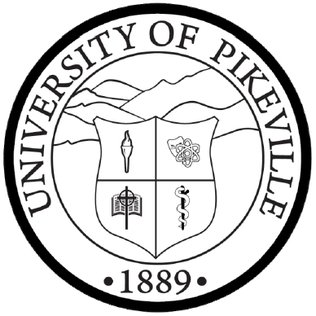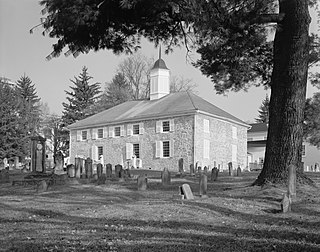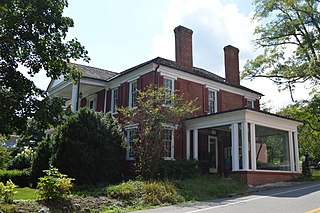
Greenbrier County is a county in the U.S. state of West Virginia. As of the 2020 census, the population was 32,977. Its county seat is Lewisburg. The county was formed in 1778 from Botetourt and Montgomery counties in Virginia.

Lewisburg is a city in and the county seat of Greenbrier County, West Virginia, United States. The population was 3,930 at the 2020 census.

Knoxville College is a historically black liberal arts college in Knoxville, Tennessee, United States, which was founded in 1875 by the United Presbyterian Church of North America. It is a United Negro College Fund member school.

The West Virginia School of Osteopathic Medicine (WVSOM) is a public medical school in Lewisburg, West Virginia. Founded in 1974, WVSOM is one of three medical schools in West Virginia and the sole institution that grants the Doctor of Osteopathic Medicine (D.O.) degree. WVSOM currently has 778 students, and focuses on primary care and rural medicine.

The University of Pikeville (UPIKE) is a private university affiliated with the Presbyterian Church (USA) and located in Pikeville, Kentucky. It was founded in 1889 by the Presbyterian Church and is located on a 25-acre (10 ha) campus on a hillside overlooking downtown Pikeville.

Andrew Lewis was an Irish-born American surveyor, military officer and politician. Born in County Donegal, he moved with his family to the British colony of Virginia at a young age. A colonel in the Virginia militia during the French and Indian War, and brigadier general in the American Revolutionary War, his most famous victory was the Battle of Point Pleasant in Dunmore's War in 1774, although he also drove Lord Dunmore's forces from Norfolk and Gwynn's Island in 1776. He also helped found Liberty Hall in 1776.

Tasker Howard Bliss was a United States Army officer who served as Chief of Staff of the United States Army during World War I, from September 22, 1917 until May 18, 1918. He was also a diplomat involved in the peace negotiations of the war, and was one of the co-signatories of the Treaty of Versailles for the United States.

George William Kitchin was the first Chancellor of the University of Durham, from the institution of the role in 1908 until his death in 1912. He was also the last Dean of Durham to govern the university.
The Greenbrier Military School was a boys-only, private, military, boarding high school and Junior College, located in Lewisburg, West Virginia. The school was founded in 1812 and closed in 1972, when the campus was converted into the West Virginia School of Osteopathic Medicine. The sister school was Greenbrier College.
University of Nashville was a private university in Nashville, Tennessee. It was established in 1806 as Cumberland College. It existed as a distinct entity until 1909; operating at various times a medical school, a four-year military college, a literary arts college, and a boys preparatory school. Educational institutions in operation today that can trace their roots to the University of Nashville include Montgomery Bell Academy, an all-male preparatory school; the Vanderbilt University Medical School; Peabody College at Vanderbilt University; and the University School of Nashville, a co-educational preparatory school.

The Battle of Droop Mountain occurred in Pocahontas County, West Virginia, on November 6, 1863, during the American Civil War. A Union brigade commanded by Brigadier General William W. Averell defeated a smaller Confederate force commanded by Brigadier General John Echols and Colonel William L. "Mudwall" Jackson. Confederate forces were driven from their breastworks on Droop Mountain, losing weapons and equipment. They escaped southward through Lewisburg, West Virginia; hours before a second Union force commanded by Brigadier General Alfred N. Duffié occupied the town.

Carnegie Hall, Inc. is a regional cultural center located in Lewisburg, West Virginia, United States. It is within the Allegheny Mountains. Monroe, Greenbrier, Pocahontas and Summers Counties are included in Carnegie Hall, Inc.’s primary service area. This region encompasses approximately 2,900 square miles (7,500 km2) and 73,000 people.

The Greenbrier River Watershed Association (GRWA) is one of the oldest watershed associations in the state of West Virginia, founded in 1990. It has supported the creation of other watershed associations throughout the state and maintains a policy of "upstream courtesy" and "downstream courtesy" with its neighbors.
Beverley Randolph Mason was an American military officer and educator who was the founder and principal of the Gunston Hall School for young women in Washington, D.C. Mason was a great-grandson of George Mason, author of the Virginia Bill of Rights.

Old Stone Church is a historic Presbyterian church located at Lewisburg, Greenbrier County, West Virginia.

The East Tennessee Female Institute was an all-female institution of higher learning that operated in Knoxville, Tennessee, United States, from 1827 until 1911. Originally chartered as the Knoxville Female Academy, the school offered high school and college-level courses to the women of Knoxville and surrounding counties in the years before the University of Tennessee became coeducational. With the rise of free public education in Knoxville in the early 1900s, enrollment at the institute, which was tuition-based, gradually declined.

Henry Ruffner, was an educator and Presbyterian minister, who served as president of Washington College. Although a slaveholder, Ruffner became known for criticizing slavery as impeding Virginia's economic development before the American Civil War, although that controversial position caused him to resign his college presidency and retire to his farm.

The John A. North House is a historic house museum and archives located in Lewisburg, Greenbrier County, West Virginia. Currently, the North House is Greenbrier County's only historic house museum. Since 1976, The Greenbrier Historical Society has operated within the North House, and in 1992 the North House was officially purchased by the Greenbrier Historical Society. In 1992, the home officially became known as "North House Museum, Greenbrier Historical Society."
The Mathews family is an American political family originally descended from Samuel Mathews (d.1657) [and later American pioneer John Mathews] and Ann Archer, originating in colonial Virginia and active in Virginia and the American South in the 17th–20th centuries.

The Battle of Lewisburg occurred in Greenbrier County, Virginia, on May 23, 1862, during the American Civil War. A Union brigade commanded by Colonel George Crook soundly defeated a larger Confederate force commanded by Brigadier General Henry Heth. Panicked Confederate forces escaped by crossing and burning a bridge across the Greenbrier River.
















